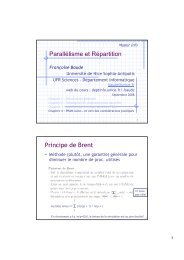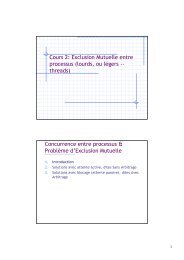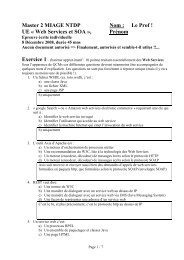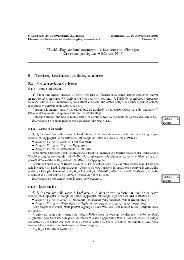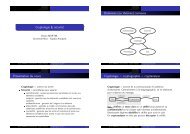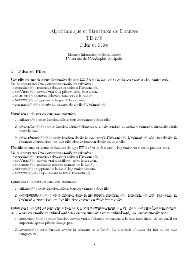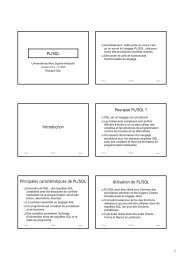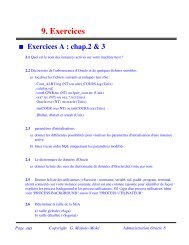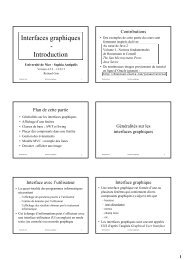TikZ and pgf
TikZ and pgf
TikZ and pgf
Create successful ePaper yourself
Turn your PDF publications into a flip-book with our unique Google optimized e-Paper software.
1<br />
0.5<br />
\begin{tikzpicture}[scale=3]<br />
\clip (-0.6,-0.2) rectangle (0.6,1.51);<br />
\draw[step=.5cm,style=help lines] (-1.4,-1.4) grid (1.4,1.4);<br />
\filldraw[fill=green!20,draw=green!50!black]<br />
(0,0) -- (3mm,0mm) arc (0:30:3mm) -- cycle;<br />
\draw[->] (-1.5,0) -- (1.5,0); \draw[->] (0,-1.5) -- (0,1.5);<br />
\draw (0,0) circle (1cm);<br />
\foreach \x in {-1,-0.5,1}<br />
\draw (\x cm,1pt) -- (\x cm,-1pt) node[anchor=north] {$\x$};<br />
\foreach \y in {-1,-0.5,0.5,1}<br />
\draw (1pt,\y cm) -- (-1pt,\y cm) node[anchor=east] {$\y$};<br />
\end{tikzpicture}<br />
−1 −0.5 1<br />
This is quite nice, already. Using these anchors, Karl can now add most of the other text elements.<br />
However, −0.5 Karl thinks that, though “correct,” it is quite counter-intuitive that in order to place something<br />
below a given point, he has to use the north anchor. For this reason, there is an option called below, which<br />
does the same as anchor=north. Similarly, above right does the same as anchor=south east. In addition,<br />
below takes −1 an optional dimension argument. If given, the shape will additionally be shifted downwards by<br />
the given amount. So, below=1pt can be used to put a text label below some point <strong>and</strong>, additionally shift<br />
it 1pt downwards.<br />
Karl is not quite satisfied with the ticks. He would like to have 1/2 or 1 2<br />
shown instead of 0.5, partly to<br />
show off the nice capabilities of TEX <strong>and</strong> <strong>TikZ</strong>, partly because for positions like 1/3 or π it is certainly very<br />
much preferable to have the “mathematical” tick there instead of just the “numeric” tick. His students, on<br />
the other h<strong>and</strong>, prefer 0.5 over 1/2 since they are not too fond of fractions in general.<br />
Karl now faces a problem: For the \foreach statement, the position \x should still be given as 0.5 since<br />
<strong>TikZ</strong> will not know where \frac{1}{2} is supposed to be. On the other h<strong>and</strong>, the typeset text should really<br />
be \frac{1}{2}. To solve this problem, \foreach offers a special syntax: Instead of having one variable \x,<br />
Karl can specify two (or even more) variables separated by a slash as in \x / \xtext. Then, the elements<br />
in the set over which \foreach iterates must also be of the form 〈first〉/〈second〉. In each iteration, \x will<br />
be set to 〈first〉 <strong>and</strong> \xtext will be set to 〈second〉. If no 〈second〉 is given, the 〈first〉 will be used again.<br />
So, here is the new code for the ticks:<br />
1<br />
1<br />
2<br />
\begin{tikzpicture}[scale=3]<br />
\clip (-0.6,-0.2) rectangle (0.6,1.51);<br />
\draw[step=.5cm,style=help lines] (-1.4,-1.4) grid (1.4,1.4);<br />
\filldraw[fill=green!20,draw=green!50!black]<br />
(0,0) -- (3mm,0mm) arc (0:30:3mm) -- cycle;<br />
\draw[->] (-1.5,0) -- (1.5,0); \draw[->] (0,-1.5) -- (0,1.5);<br />
\draw (0,0) circle (1cm);<br />
\foreach \x/\xtext in {-1, -0.5/-\frac{1}{2}, 1}<br />
\draw (\x cm,1pt) -- (\x cm,-1pt) node[anchor=north] {$\xtext$};<br />
\foreach \y/\ytext in {-1, -0.5/-\frac{1}{2}, 0.5/\frac{1}{2}, 1}<br />
\draw (1pt,\y cm) -- (-1pt,\y cm) node[anchor=east] {$\ytext$};<br />
\end{tikzpicture}<br />
−1 − 1 2<br />
1<br />
Karl is quite pleased with the result, but his son points out that this is still not perfectly satisfactory:<br />
The grid <strong>and</strong> − 1 2 the circle interfere with the numbers <strong>and</strong> decrease their legibility. Karl is not very concerned<br />
by this (his students do not even notice), but his son insists that there is an easy solution: Karl can add the<br />
[fill=white] option to fill out the background of the text shape with a white color.<br />
The next −1thing Karl wants to do is to add the labels like sin α. For this, he would like to place a label<br />
“in the middle of line.” To do so, instead of specifying the label node {$\sin\alpha$} directly after one<br />
of the endpoints of the line (which would place the label at that endpoint), Karl can give the label directly<br />
after the --, before the coordinate. By default, this places the label in the middle of the line, but the pos=<br />
options can be used to modify this. Also, options like near start <strong>and</strong> near end can be used to modify this<br />
position:<br />
34






